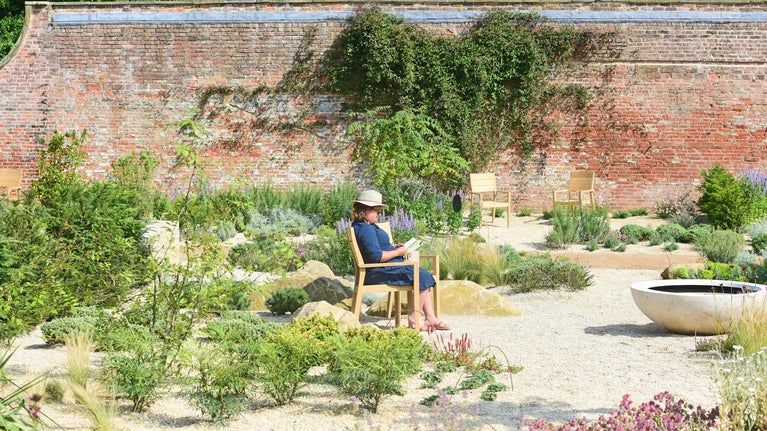Andy Sturgeon-designed Mediterranean Garden boosts climate resilience and biodiversity as Beningbrough Hall continues its revival

A new Mediterranean Garden, designed for a changing climate by award-winning garden designer Andy Sturgeon, has been unveiled at the National Trust’s Beningbrough Hall near York.
Since 2016, Andy has been working with the Trust on a long-term project to improve and in some cases reinvent the 8-acre garden, and the Mediterranean Garden is the largest phase of his garden vision to open to date.
Formerly an underused grassed area, the garden now features over 4,000 herbaceous perennials, grasses, trees and shrubs from Mediterranean climate zones around the world, from South Africa to South Korea, Chile, China, Australia and the Mediterranean itself.
Inspired by the Italian-style baroque hall, Andy selected plants from Mediterranean climates that are better able to cope with hotter, drier summers and wetter winters, ensuring the garden’s resilience in the face of climate change.
Drought-tolerant plants will need less watering, while the introduction of more free-draining soil, and additional drainage, will help manage intense rainfall. Once the plants have established, the garden will not receive supplementary watering.
Designer Andy Sturgeon said: “In the UK we can expect warmer summers with prolonged dry periods and drought, but also an increase in very wet days, particularly in winter. We need to start changing the way we garden and I have taken the opportunity to embrace this at Beningbrough.
“What we have created is in effect a vast gravel garden that sits comfortably in the historic setting – I hope that it will feel quite timeless.”
The design is set to enhance the biodiversity of the garden: 3,500 of the new plants are on the RHS Plants for Pollinators list, compared to only 10 in the previous planting scheme.
Among the plants in the new garden are:
- Koelreuteria paniculata (pride of India)
The Indian rain tree is a climate change specialist and is unusual for a tree growing in the UK as its yellow flowers appear in summer. The slender open structure of this deciduous tree becomes more beautiful with age.
- Ozothamnus ‘Silver Jubilee’
This fast-growing shrub, with soft grey leaves, is all about texture. Although hailing from New Zealand it enhances the Mediterranean quality of a garden; the pale flowers are a welcome bonus.
- Grevillea ‘Canberra Gem’ (spider flower)
The hardiest of all grevilleas, this Australian evergreen shrub has stunning deep pink, almost red flowers that appear in late winter. It will keep flowering for six months.
- Kniphofia ‘Tawny King’ (red-hot poker)
The tubular flowers open orange and fade to cream. This robust poker stands about 90cm tall above evergreen leaves, bringing a stately, exotic air.
- Stipa gigantea (golden oats)
The golden stems and flowers float over the surrounding planting, catching the light as they sway in the breeze.
A large tank has been constructed underneath the garden, which will capture excess rainfall and slowly release it to prevent flash flooding.
Extremes in local weather over the past year have underlined the need to adapt Beningbrough’s garden.
Head Gardener Sam Shipman said: “Since starting the build in 2023, it has rained almost every day, holding up our progress. The irony of building a Mediterranean garden in one of the wettest autumns, winters and then springs on record has not been lost on any of us.”
Alongside the plants, hard landscaping is an important part of the new design. A series of long, low walls made from local York stone emerges from the sloping ground, providing structure, while boulders around the garden give the flavour of a Mediterranean hillside. Winding pathways reveal fresh viewpoints, hidden corners, and welcoming seating areas.
Among the planting and seats are water bowls with miniature lilies, spaced to attract wildlife and create reflections through the garden. All plants have been grown peat-free and the bowls, boulders and stone were sourced from local artisans and quarries.
Andy Sturgeon said: “I think the success of this garden comes from the marriage of the ancient red brick walls, the presence of the Hall towering over it and the elegance and textural beauty of the new planting.”
The design draws on archive photographs and archaeological research which showed there was likely a series of ponds and a fountain in this part of the garden around 1900.
Sam continued: “We have returned water to this part of the garden in the form of a rill on one of the walls, flowing into a new pond with stepping stones across it. The sound of its three spouts really adds to the relaxing feel of the garden.”
National Trust Head of Gardens and Parklands, Andy Jasper, said: “With more intense weather events, including drought and floods, predicted, our gardens need to change to better tolerate extremes.”
Andy concluded: “The new Mediterranean Garden sits perfectly alongside the Italian architecture of the hall. Over the centuries, the hall has been constantly reinvented – this new garden continues that spirit of renaissance. We hope that visitors will enjoy this garden, but also be inspired to future proof their own gardens.”
The redevelopment was made possible by the late Mr Ian Reddihough who left a generous gift in his will to support the ongoing development of Beningbrough. This money has enabled the garden vision to progress and will continue to support ongoing projects each year.